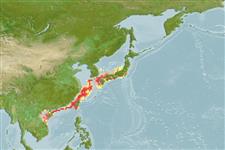>
Ovalentaria/misc (Various families in series Ovalentaria) >
Pomacentridae (Damselfishes) > Chrominae
Etymology: Chromis: Greek, chromis = a fish, perhaps a perch (Ref. 45335); onumai: Named for Hisashi Onuma, who first discovered the species.
Eponymy: Hisashi Onuma “who was the first to discover the species” was also thanked for his assistance in collecting the new damselfish at Izu-oshima Island, Japan, “and for his excellent underwater photographs.” (Ref. 128868), visit book page.
Environment: milieu / climate zone / rango de profundidad / distribution range
Ecología
marino asociado a arrecife; rango de profundidad 51 - 90 m (Ref. 75861). Temperate
Northwest Pacific: Taiwan and Japan.
Tamaño / Peso / Age
Madurez: Lm ? range ? - ? cm
Max length : 12.6 cm SL macho / no sexado; (Ref. 75861)
Short description
Claves de identificación | Morfología | Morfometría
Espinas dorsales (total) : 14; Radios blandos dorsales (total) : 12 - 13; Espinas anales: 2; Radios blandos anales: 12 - 13; Vértebra: 26. This species is characterized by the following: D XIV, 12-13; A II, 12-13; pectoral fin rays 19-20; 3 spiniform caudal fin rays; 16-17 tubed lateral line scales; gill rakers 5-7 + 19-20 = 25-27; white spots about a pupil size posteriorly, 1 at rear base of dorsal fin, another at the rear base of anal fin, and the third at mid base of caudal fin (these 3 spots usually fading after death, but may be visible as a pale area on preserved specimen) (Ref. 75861).
Body shape (shape guide): short and / or deep; Cross section: compressed.
Life history characteristics for the family specify that this group is oviparous, with distinct pairing during breeding (Ref. 205). Eggs are demersal and adhere to the substrate (Ref. 205). Males guard and aerate the eggs (Ref. 205).
Life cycle and mating behavior
Madurez | Reproducción | Puesta | Huevos | Fecundidad | Larva
Oviparous, distinct pairing during breeding (Ref. 205). Eggs are demersal and adhere to the substrate (Ref. 205). Males guard and aerate the eggs (Ref. 205).
Senou, H. and T. Kudo, 2007. A new species of the genus Chromis (Perciformes: Pomacentridae) from Taiwan and Japan. Bull. Nat. Mus. Nat. Sci. Ser. A. Suppl. 1:51-57. (Ref. 75861)
IUCN Red List Status (Ref. 130435: Version 2025-1)
Threat to humans
Harmless
Human uses
Herramientas
Special reports
Download XML
Fuentes de Internet
Estimates based on models
Preferred temperature (Referencia
123201): 17.2 - 23.7, mean 21.9 °C (based on 22 cells).
Phylogenetic diversity index (Referencia
82804): PD
50 = 0.5000 [Uniqueness, from 0.5 = low to 2.0 = high].
Bayesian length-weight: a=0.01820 (0.00804 - 0.04119), b=2.99 (2.81 - 3.17), in cm total length, based on LWR estimates for this Genus-body shape (Ref.
93245).
Nivel trófico (Referencia
69278): 3.0 ±0.1 se; based on size and trophs of closest relatives
Resiliencia (Referencia
120179): Alto, población duplicada en un tiempo mínimo inferior a 15 meses (Preliminary K or Fecundity.).
Fishing Vulnerability (Ref.
59153): Low vulnerability (10 of 100).
🛈
